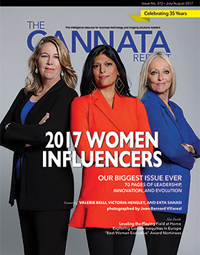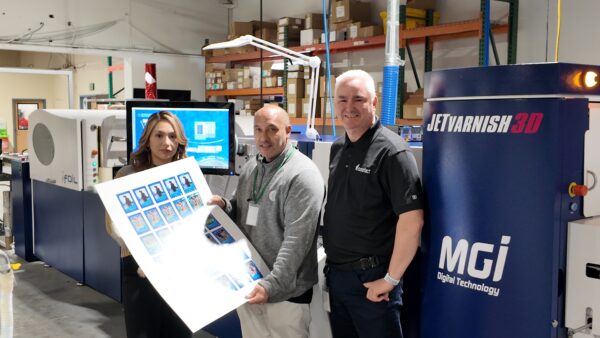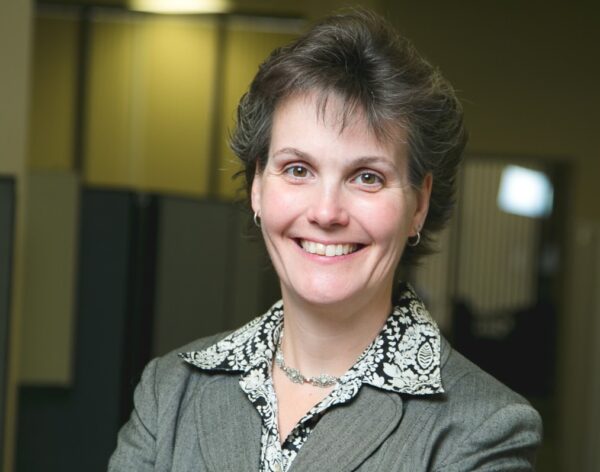Konica Minolta lays the groundwork to transition from a hardware company to a data company.
Above: Jun Haraguchi, president, Konica Minolta Japan, Inc. gives us a warm welcome in the reception area
For Konica Minolta, Inc., the future is data, not hardware.
Don’t get us wrong, Konica Minolta is not abandoning the print business, but it is transforming itself from a hardware company into a data company. That was just one of the things we learned talking to Jun Haraguchi, Haraguchi, President, Konica Minolta Japan, Inc., and president, Konica Minolta Japan, Inc., during the first meeting of our Japan trip.
After a gourmet lunch in a private suite at The Prince Gallery Tokyo Kioicho hotel’s Washoku Souten restaurant in the Akasaka District with Harguchi; Shoei Yamana, president and CEO, and ToshimitsuTaiko, senior executive officer in charge of business technologies, we moved to the Konica Minolta headquarters for our interview.
MFPs, to Production, to Workplace Hub
No matter which Big Six OEM we visited during our trip to Japan, the MFP still loomed large in our discussions, dispelling any thoughts of the technology’s demise, even though much of those discussions centered around how the concept of the MFP is changing.
At Konica Minolta, the MFP is evolving into a data collection device. That’s not a unique perspective, as other OEMs are thinking that way too, but it’s a trend worth watching. For a device rooted in copying and printing, this advanced view of the MFP offers a glimpse into what’s going on in the R&D facilities of the MFP manufacturers.
Haraguchi reported the Japanese market is saturated with MFPs. He referenced an MIF of one million, acknowledging the market may realistically only need about 500,000 units because of changes in the way people work, including the fact they’re not printing or copying as much as they once did.
Haraguchi further explained the MFP has become an IT solution that handles data””data that can track a worker’s behavior. We don’t think he meant anything nefarious by that, rather he was referencing how it could track what, where, when, and how workers print or scan.
Because of this change, Konica Minolta has hired data scientists who will help the company create a more data-oriented business.
“We cannot kill the MFP,” said Haraguchi. “We have to evolve it, so we can maintain our customer base.”
We actually started our discussion talking about the KM-1 production printer, a product introduced a year ago and referenced in Frank and CJ’s meeting with Haraguchi during their last trip to Japan four years ago. Haraguchi reported Konica Minolta continues to receive raves about the KM-1’s image quality and that the device has proven to be great for short runs. He added that Konica Minolta continues to do well in production print overall, driven by on-demand printing.
Any meeting with Konica Minolta can’t ignore Workplace Hub, the company’s landmark product, announced last year
in Berlin, Germany, and its relationship to the MFP. We were curious about the current status of that product, which has yet to hit the market at press time.
Haraguchi didn’t offer a timetable for its release, instead focusing on positioning, something that will be important to all channels selling Workplace Hub.
“It’s not rocket science,” he explained. “As a manufacturer, Konica Minolta must understand times have changed, and customer requirements are not limited to hardware.”
The key components of the Workplace Hub concept are applications and service, and Workplace Hub will tie all the technology and applications, including MFPs and data, in an organization together. He sees businesses driving the data within their organizations and critical business processes through it. Of course, he views this as a huge opportunity for Konica Minolta and its dealers.
“We can be a one-source provider in terms of networking,” he said, adding that the device is a good fit for SMBs.
And as new services and applications emerge, those can be integrated into Workplace Hub, adding even more value.
One of the burning questions surrounding Workplace Hub is how dealers can derive revenue from it. Haraguchi touted a usage model. For example, a dealer could charge for an accounting application, or charge the customer for running their teleconference system through it. Either way, the customer receives one invoice with every monthly charge based on usage.
“If we can charge based on usage, it’s a very comfortable method,” said Haraguchi.
The Changing Workplace
Viewing the MFP as a data collection device, and adding a device like Workplace Hub to tie everything in the workplace together, illustrates how Konica Minolta is adapting its product offerings to changes in the workplace and the way people work. As Haraguchi told us, Konica Minolta wants to be at the forefront of innovation in changing the way people work.
He asserted that the ways people work and communicate are too convoluted and could be made more efficient. As Konica Minolta spends less of its R&D efforts on hardware, the company’s emphasis is on moving to the cloud and developing mobile applications to address the shifting trends in how and where people work. Tipping his hand, Haraguchi noted how working remotely could be the perfect solution for workers in cities like Tokyo and New York. If that’s the trend for the future, Konica Minolta is looking to be at the forefront of that change, designing solutions for an expanding remote workforce.
What’s Next?
With the workplace in flux, Haraguchi emphasized that Konica Minolta must change as well. He acknowledged the old way of working was based on mass product marketing””making more product, selling more product, and cutting costs associated with making and selling products.
“Customers don’t want product, they want the service,” he said. “We can’t continue to sell what the customer doesn’t want.”
That’s a bold statement coming from an OEM, and Haraguchi suggested sales reps need to learn what customers are looking for, otherwise Konica Minolta can’t help them.
We concluded our conversation with Haraguchi by asking him what message he would like us to deliver to our audience
about Konica Minolta’s future direction.
At that point, he circled back to the MFP, opining that it has not yet reached the end of its product lifecycle, observing, “It’s a digital device which still has value in a digital world.”
Haraguchi also empahsized that dealers really have to start thinking about changing their business models as the focus shifts from hardware to data. Inside his Japan dealer network, he’s discussing moving from a transactionalbased hardware sale to deriving revenue from usage and/or licensing fees. This discussion is applicable to dealers in the U.S. as well.
Access Related Content
Visit the www.thecannatareport.com. To become a subscriber, visit www.thecannatareport.com/register or contact cjcannata@cannatareport.com directly. Bulk subscription rates are also available.





